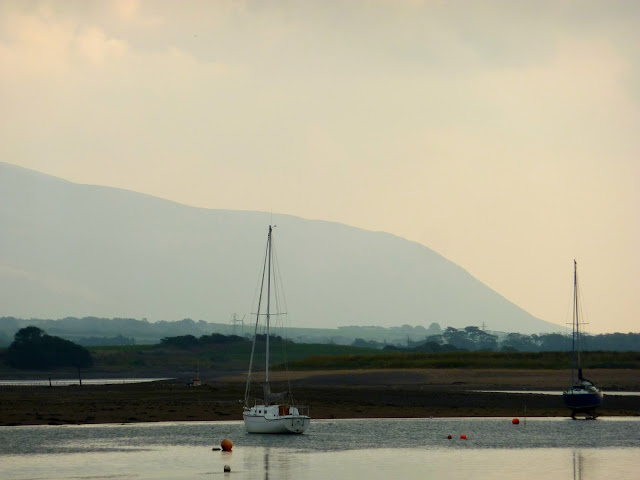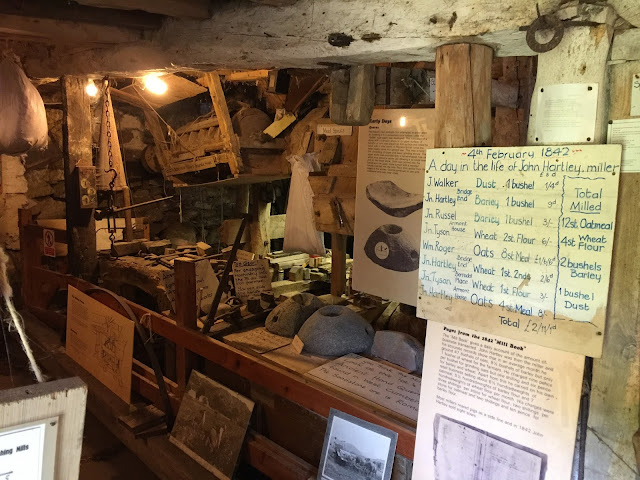The
only coastal village in the Lake Districts National Park, Ravenglass is reputed
to date back to the second century when it was an important navel base for the
Romans. Although it's probably changed since Roman times it certainly hasn't
changed a lot in the last few hundred years! Quaint would go some way to
describe it with a generally neat row of small two storey cottages each side of
its only main street. With only one shop, a rather rundown Post Office with a friendly
owner whose cat sits on the counter and with little stock on the shelves
visitors are advised to shop before they arrive for a lengthy stay but it's
still worth a visit and it is the only place locally that sells newspapers!
 |
| Community Hall. |
 |
| and the Post Office. |
One
of the main tourist attractions of this small coastal town is its miniature
railway that runs a seven-mile stretch of narrow gauge rail track through some
spectacular Lake District countryside to Eskdale and the Dalegarth Station
where you embark in the shadow of Scafell Pike. La'al Ratty, as the railway is
known, has a very long history and some of it can be sampled at the railway
museum that adjoins Ravenglass's main line station where regular trains run
from Barrow in Furness in the south to Carlisle in the north. Also more
information about the steam railways history can be obtained from their web
site www.ravenglass-railway.co.uk.
Once
you break your return journey at Dalegarth, the round trip takes about 2 hours
in all; you have a chance to explore locally on foot. Boot Village is only a short walk and boasts
a pub/restaurant and an ice cream shop but don't miss a chance to explore
Eskdale Mill full of artifacts, photographs and lots of information. Visitors
can actually see the water wheel in action. Go around the back of the building
and see the beautiful watercourse. For further information go to www.eskdalemill.co.uk
 |
| Boot Village. |
On
leaving the village follow the footpath signs to St Catherine’s Church and then
across the rather precarious stepping-stones to ford the River Esk and follow
the signs for Stanley Gill and the Dalegarth Falls. The walk will take a couple
of hours and follows a fast flowing river up an ever-narrowing ravine with a
precipitous drop. Could be quite dangerous for young children and people unsteady
on their feet but the final result is a close view of the falls surrounded by
its ‘Lord of the Rings’ type forest. Back to the railway station for coffee and
cake and the small gauge rail journey back to Ravenglass in an open carriage
accompanied by the unique smell of steam pouring out of the miniature engine.
A
very strange English eccentricity took place at the station the following
morning: Border Style Morris Dancing! A weird group of people
perform this ‘ritual’ which is based in West Cumbria and call themselves ‘The Two
Headed Sheep’. Difficult to describe their routine but it involved a dance
dressed in a costume and banging sticks together, but they seemed to enjoy
themselves!
The Romans.
Ravenglass
was located at the western extremity of the Roman frontier and as I have said
there's not a lot left of the Romans - except that is for the remains of a
Roman bathhouse. Ravenglass's Roman occupation lasted for over 300 years, so I
suppose it's only right if your away from home for that amount of time you may
require a good scrub once in a while and considering there were 500 solders in
the garrison it certainly had to be a large bath! It is one of the largest
remaining Roman structures in England. Approximately a miles walk from the
remains is Muncaster Castle and its gardens.
Muncaster Castle.
Rumoured
to be haunted, Muncaster Castle is the ancestral home of the Pennington family
who have lived there 800 years and who still live in part of the castle with the
rest set a side for public gaze - at a price of course. But for £13:50 you get
a fair bit for your money not only a look around the castles 'elegant rooms,
historical furnishings and superb works of art' but also the grounds which
displays plants, shrubs and trees from all over the world and did have the
largest collection of rhododendrons in Europe (I wonder who has the biggest
collection now?). Well that's not all, included in the ticket money is a visit
to the hawk and owl centre, a display of various birds of pray and the 4 o’clock
feeding of a flock of herons who come to the castle for a feed every day, eight
birds were spotted during the feed. Which raises the age-old question how do
birds tell the time?





































No comments:
Post a Comment